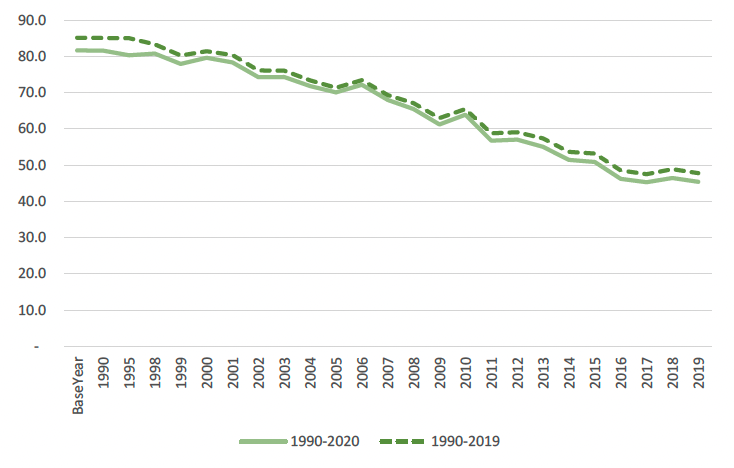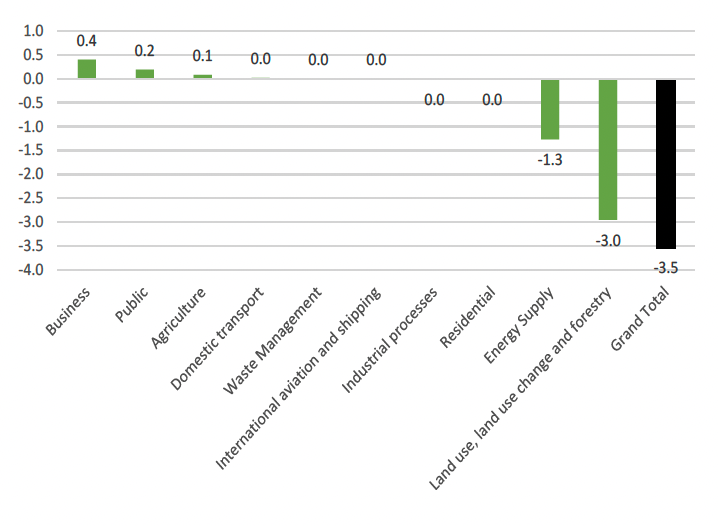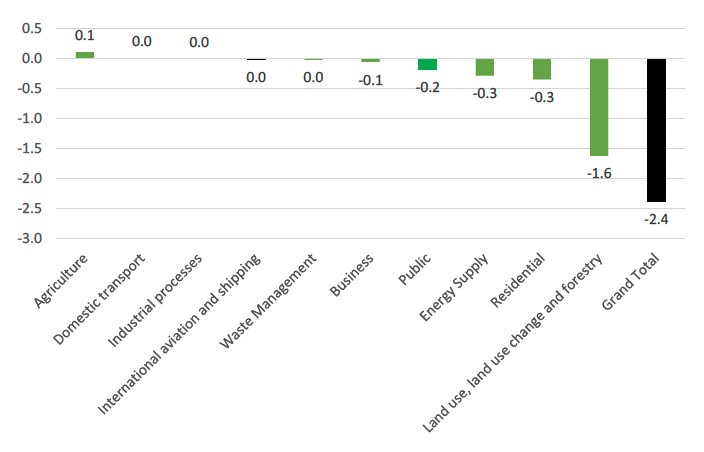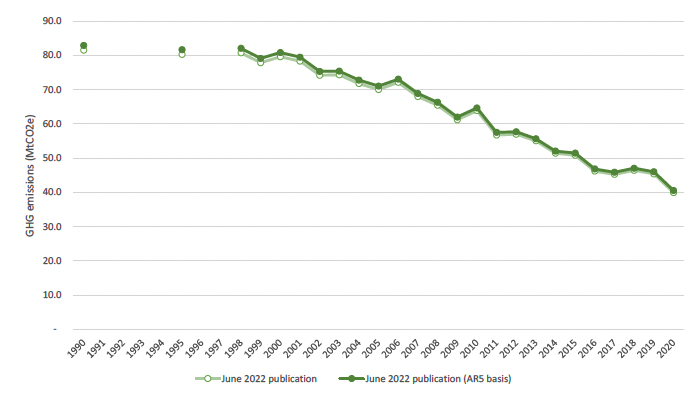Scottish Greenhouse Gas Statistics 2020
Official statistics showing emissions of greenhouse gases in Scotland over the period 1990 to 2020.
This document is part of a collection
Section D. Revisions to the Inventory and Methodology
This section examines key revisions in estimated source emissions between the latest inventory (1990-2020) and the previous inventory (1990-2019). It also provides a summary of the cumulative impact of revisions since the 1990-2008 inventory. In October 2015, the Scottish Government published a paper Scottish Greenhouse Gas Emissions 2013. Key Revisions Since 2008, which provides a breakdown of the key revisions to the data within the Scottish Greenhouse Gas Emissions Official Statistics publication over successive years from the 1990-2008 inventory to the 1990-2013 inventory. This section of the publication is intended to build on this revisions paper.
Compilation of the Greenhouse Gas Inventory
The greenhouse gas inventory covers a wide variety of anthropogenic sources of greenhouse gas emissions. There is therefore a wide variety of emissions sources which require different approaches to their estimation. There are a large number of data sources used in its compilation, obtained from Government statistics, regulatory agencies, trade associations, individual companies, surveys and censuses. The methods used to compile the greenhouse gas inventory are consistent with international guidance on national inventory reporting from the Intergovernmental Panel on Climate Change.
Most emission estimates are compiled by combining activity data (such as fuel use) with a suitable emission factor (such as amount of CO2 emitted per unit of fuel used). Estimates of emissions from the industrial sector are often compiled based on plant-specific emissions data. Emissions from some sectors are based on more complicated models - such as the model used to estimate emissions from landfill, and the model used to estimate the carbon dynamics in soils when trees are planted. Much of the data on net emissions from 'agriculture' and 'land use, land use change and forestry emissions' are based on modelled data for Scotland, which are consistent with, but not constrained to, the UK totals and thus are known as "bottom up" estimates.
Many of the remaining emissions sources within the inventory have been collated on a "top down" approach where estimates of emissions have been apportioned to Scotland using proportions of energy use in the Department of Business, Energy and Industrial Strategy (BEIS) Publication "Digest of UK Energy Statistics (DUKES)". This approach is prompted by data availability on emissions being more limited at the sub-UK level.
Impact of Revisions
Revisions between the 1990-2019 and 1990-2020 inventories
Charts D1 to D3 illustrate the impacts of revisions between the 1990-2019 and 1990-2020 inventories. This is followed by a discussion of the reasons for the key revisions.

Chart D2 shows revisions to the baseline period, between the two most recent inventories.

Chart D3 shows revisions to the data for the year 2019, between the two most recent inventories.

Details of Main Revisions and Interpretation of Revisions to the Inventory
Revisions to emission inventory estimates reflect the continuous development of scientific understanding of emissive processes, and the improvement to underlying data and methods to generate accurate emission estimates; few revisions to the Greenhouse Gas Inventories arise as a result of 'errors' in the popular sense of the word. The compilation of the inventory is governed by a rigorous quality assurance process and is subject to a great deal of third party scrutiny, such as annual reviews by the UNFCCC of the UK inventory.
The latest published Scotland greenhouse gas inventory (currently 1990-2020) represents the best available data at the time and these supersede any previous data, which should be disregarded.
A complete list of the revisions between the previous and latest inventories can be found in the National Atmospheric Emissions Inventory report Greenhouse Gas Inventories for England, Scotland, Wales and Northern Ireland: 1990 - 2020. Details of the most notable revisions are listed below:
LULUCF revisions
Charts D2 and D3 show a substantial revision to the LULUCF category in both the baseline period and the latest year – affecting all intervening years. These revisions represent a profound improvement to the underlying data and methodology used to construct emissions estimates for LULUCF emissions.
In previous years' inventories, data on land use were generally constructed from infrequent surveys whereas this release sees the introduction of a new method which uses multiple time-series sources (for example, remote sensing data) to arrive at frequently updated probabilistic estimates of land use for each land area.
Energy supply
Revisions are primarily due to significant recalculations due to method improvements for the early part of the time-series resulting from the oil and gas improvement project, including alignment to UK oil and gas data for 1990-1997.
Business
Integration of new mapping grids for the use of fuels at industrial sites, particularly for gas oil, coal, fuel oil and natural gas use impacts emissions across the time-series.
Following feedback from the UNFCCC, emissions from stationary combustion in the iron and steel industry (IPCC sector 1A2a) were relocated to iron and steel production (IPCC sector 2C1b) in the UK inventory, impacting emissions for each DA.
Emissions for later years of the time-series were affected by recalculations in the DUKES activity data.
Residential and public combustion
Recalculations due to revisions to the mapping grid analysis of fuel used in domestic and public combustion, particularly solid fuel use affects the early part of the time-series. Revisions in later years include the impact of DUKES recalculations as well.
Interpretation of uncertainties in the inventory
All estimates, by definition, are subject to a degree of statistical 'error' but in this context it relates to the uncertainty inherent in any process or calculation that uses sampling, estimation or modelling.
Estimates of greenhouse gases are compiled by a consortium of contractors. The source emissions are based upon a range of data sources, ranging from model based estimates to point source emission data. As a result, the estimates are subject to a degree of uncertainty. Full analyses of these uncertainties are provided on the National Atmospheric Emissions Inventory website[7].
The Scottish Government previously commissioned research to overhaul and update the uncertainties model used for the Scottish greenhouse gas inventory. A detailed study was carried out in parallel with the compilation with the 1990-2014 Scottish greenhouse gas inventory to review and improve the uncertainty calculations. A link to this project and to the full report can be found in the Scottish Greenhouse Gas Inventory Uncertainties Project.
Future revisions to the inventory
Every year, greenhouse gas inventories are updated to reflect improvements in the underpinning science, data and modelling which often result in revisions to the entire time series. These revisions also reflect changes to the Intergovernmental Panel on Climate Change (IPCC) guidelines. The Scottish Government is represented at the UK's National Inventory Steering Committee, where improvements to the Scottish and UK inventories are discussed.
Following the recent UNFCCC COP26 meeting in Glasgow, it was confirmed that the greenhouse gas warming potentials used in this release will move to those presented in IPCC Annual Report 5 (AR5) without climate feedback effects. This change is expected to occur in the next edition of this publication and will result in methane moving from a GWP multiplier of 25 to 28, and nitrous oxide reducing from 298 to 265. Other changes to individual isotopes of fluorinated gases will also be made.

In isolation, these revisions are expected to increase 1990 emissions by 1.4 MtCO2e and 2020 emissions by around 0.6 MtCO2e.
Contact
Email: CCStatsModelling@gov.scot
There is a problem
Thanks for your feedback